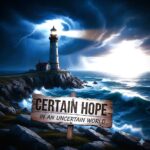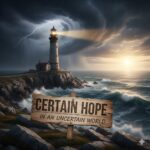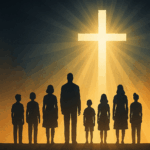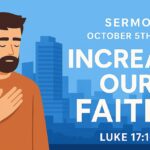“The Spirit of God Hovering Over the Water” – Genesis 1:2 & Mark 1:9-11
Introduction: The Old Testament reading, and hovering
In the olden days, the Old Testament lesson paired with the Gospel reading of Jesus’ Baptism was always from Isaiah 42, where we read, “Behold my servant, whom I uphold, my chosen, in whom my soul delights; I have put my Spirit upon Him.” Those words may be familiar to you, and they certainly connect with the words from the voice from heaven at Jesus’ Baptism. And since the focus of this Sunday is definitely the Baptism of Jesus, and since the Romans 6 lesson is also very defined in its emphasis on Baptism, I really haven’t paid much attention to the Old Testament lesson recently. So, it was a little bit surprising to me to do that – to pay attention to how the appointed reading from Genesis 1 connects with the theme of this day. But it does, and that’s what we’re going to look at and explore and reflect on today.
Perhaps one of the more popular Christmas gifts in recent years has been those flying drones with a built-in camera. You can get them now for as cheap as $100. I’m not sure if they are primarily a toy, a security system, or a means to spy on your neighbours. But the fascinating thing that they do is… hover. There are not a lot of creatures that hover because most of them need to be moving forward to achieve flight. But bats, and dragonflies and hovering birds / humming birds do have the capacity to hover, to stay airborne in place. In the last 100 years, human beings have invented devices that enable us to hover – like a helicopter from 1939, and hovercraft from the 1950’s, and now these little drones. So, yes human beings now have the ability to hover. I’ve never done it… OK, well, maybe I have hovered over my kids sometimes, but not airborne. They even call that being a “helicopter parent.”
So, I find it interesting, curious, intriguing that the second verse of the entire Bible says that the Spirit of God was hovering – hovering over the formless and empty and dark and deep surface of the waters at the time of creation. Nothing specific really seems to have been created yet, but there is a sense of the Holy Spirit’s hovercraft presence waiting to be put into action, creative action over some undetermined mixture of liquid and solid.
1. Creation – with Jesus and the Holy Spirit, too
We usually think of creation being in the realm of God the Father, but we know from a couple of passages in the New Testament that God the Son was involved as well. The first chapter of John states that without Jesus nothing was made that has been made. And Colossians 1 says that by Jesus all things were created – things in heaven and on earth, visible and invisible. All things were made by Him and for Him. And this little phrase in Genesis 1 involves God the Holy Spirit – hovering over the water, making things, creating things, making new things. The Bible affirms that the Father directly and intentionally called the order of the cosmos into being through the Son and the Holy Spirit. The connection to this day of Jesus’ Baptism, the connection to the other two Bible readings, is the fact that the Spirit was hovering over the WATERS, and making new things.
2. Old Testament water stories – things made new
There are other water stories in the Old Testament where things are made new. Just a few chapters later – in Genesis 6 – 9 – we hear the grand and famous story of Noah and the flood – water INDEED!! The world had changed from the intention which with God had made it. Genesis 6:5 is a sad summary: “The Lord saw that the wickedness of man was great in the earth, and that every intention of the thoughts of his heart was only evil continually.” Every intention, only evil, continually – YIKES!! From that first little bite of the forbidden fruit in the Garden of Eden, now evil had really taken a huge and infectious bite into the daily thoughts and words and deeds of these human beings who were the crown of God’s creation. With the waters of the flood, God intended to make the earth new again, creating new hearts in people, starting with Noah who found favour in the eyes of the Lord. In fact, St. Peter, in his first letter, connects the saving of Noah and his family through the water of the flood to the saving of people through the water of Baptism.
Another Old Testament account finds God hovering over the people of Israel in a pillar of protective cloud as they stood at the Red Sea with the Egyptian army behind them. Then, in a show of His majesty and power and grace, God parted that Sea, making a new path through the water, setting them on that new path toward the Promised Land, and a new life for the formerly enslaved Israelites.
Then consider Jonah – the reluctant run-away missionary. God assigned him to go East on land to Nineveh to warn the people there of their evil and to call them to repentance rather than destruction. Instead, Jonah went West by sea to avoid that uncomfortable mission impossible. But God hovered over Jonah in a fierce storm until he was tossed in the sea and swallowed by a great fish. That gave Jonah time to reconsider and when he was burped up on shore, he did a u-turn in a new direction to complete his mission impossible assignment to turn the people of Nineveh toward God in repentance. They did repent; God forgave them and made them new.
3. New Testament Baptism stories – people made new
a. Baptism… by John
Then, if we turn to the New Testament, we see some other water stories in which people are made new. Our Gospel reading from Mark 1 introduces Baptism with context from the ministry of John the Baptizer. Here is this “locust and wild honey”-eating, “camel’s hair and leather belt”-wearing, tee-totaling wild man ministering to people in the Judean wilderness with a message calling people to repentance and forgiveness for their sins. Oh, and they needed repentance, for their lives were anything but stellar and holy. Maybe more like those in Noah’s time – every intention, only evil, continually. If we bring in the same but fuller account of this John from the Gospels of Matthew and Luke, we see what kind of sinful people were coming to John for “newness of life.” There were selfish and self-centered people who were urged to share their food and clothing with the needy. There were the rich and cheating tax-collectors who were advised not to collect more than rules and regulations allowed them to. There were the bullying soldiers who threatened others by virtue of their position, and the discontent soldiers who didn’t think they were being paid enough. There were also the spiritually proud pharisees and religious leaders who thought they were right in God’s eyes just because they were descendants of “right in God’s eyes” Abraham, and who thought they didn’t have to lead spiritually pure and fruitful lives to match their repentance. John was calling ALL of these people to repentance and newness of life.
Where did this new life start? In the water, the water of the Jordan River! It wasn’t pure and pristine water that just calmly trickled by. It wasn’t emerald green water that allowed you to see every bottom dwelling pebble clearly. It wasn’t healing spa water that bubbled up from some warm underground spring. The Jordan River was plain river water that flowed down from the Galilee Lake to the dead-ended Dead Sea. It had mud and sludge in it, and sometimes it flowed at a fierce flood level, but because of God’s grace it had the power to wash away the moral mud and sludge and sin from those people’s lives. God added His Word and His promises to that plain water so that sin flowed downstream with the current and what emerged as the people came out was a new spiritual life that focused on the Kingdom of God and that bore lives that were lived out in accord with genuine repentance.
b. Baptism… of Jesus
And in those days Jesus also came to be baptized by John – not because He needed it. The Bible makes it clear that Jesus was like us in every way – even to the point of being tempted – except that He was without sin. Jesus didn’t come to be baptized because He needed to repent, because He needed that forgiveness and newness of life. He came because He wanted to stand with us sinners in all of our humanity and weakness. He didn’t just take our sins with Him to the cross of Calvary, but He took our sins with Him as He prayed earnestly and with great distress and sorrow of His soul in the Garden of Gethsemane, and He took our sins with Him when He stood face-to-face with the devil being tempted in the wilderness, and on this occasion He took our sins with Him as He stepped into the water of the Jordan to be baptized. And for that, God the Father expressed His distinct pleasure, cracking open the rift between earth and heaven, between the temporal and the eternal, between the sinful and the holy, and saying: “You are my beloved Son; with you I am well pleased.” And who was hovering around?? The Holy Spirit, like a dove, over the waters of the Jordan River.
c. Baptism… with Nicodemus
In John 3 – just before that famous John 3:16 “God so loved the world” passage – Jesus has a night-time conversation with Pharisee Nicodemus. Nicodemus implies that, because of Jesus’ miraculous signs, God must really be with Him. Nicodemus had no idea, NO IDEA how much God was with Him… Immanuel, God with us!! But Jesus kind of pivots the conversation, and starts talking about… BAPTISM!! And being born again. And how do we know that this ‘born again’ conversation is about Baptism? Jesus makes it clear: “Unless you are born of water and the Spirit, you cannot enter the kingdom of God.” And there we have it again – the Holy Spirit and water, the Holy Spirit hovering over and active in and through the water of Baptism. Jesus even expands on that imagery of hovering by talking about the wind: “The wind blows where it wishes… so it is with everyone who is born of the Spirit.” Here we may have to picture the Spirit not as a dove but as an eagle, soaring, hovering up high on the updrafts of the wind, and then coming down to hover in and over the life of a person who has come to faith in Jesus and/or who has been baptized.
d. Baptism… in Romans
And then, just to tie all this together, we have that beautiful Baptism theology passage that Paul wrote in Romans 6. Should we sin more and more so that God can demonstrate His grace and forgiveness more and more? NO!! In Baptism, we have said that sin, sinful ways and the devil are not our life’s lord. Rather, Jesus is our Lord, and by Baptism we are connected with both Jesus’ death and His resurrection. In Baptism, we drown our old sinful self, and in Baptism we rise to be God’s new and forgiven and holy person, living a new life. We count ourselves dead to sin, but alive to God in Christ Jesus. So that’s how we live – as a new creation, as a child of God, as one who has been born physically, and yet reborn spiritually.
4. We need repentance, AND forgiveness!
To be sure, we are never entirely free of sin and its influence in our lives, but it is not, it is never our lord. Yet, we, like the people in John’s day, need to be called to repentance and forgiveness for our sins, for we like the people of Noah’s day find that that “every intention, only evil, continually” reality still plagues us like a nasty virus. Whether it’s not sharing our food and clothing like the common people, or cheating and taking more than we are due like the tax-collectors, or bullying others or being discontent like the soldiers, or popping our spiritual pride buttons like the Jewish religious leaders – we all have the need to repent and to genuinely seek God’s gracious forgiveness for those sins.
Again, let me assure you of that forgiveness through Jesus the beloved Son of God. Whether you consider Jesus taking your sins into the Jordan waters or into the wilderness temptations or into the Garden of sorrowful prayer or onto the cross of horrendous suffering or ALL of those occasions together, the truth is that Jesus took the full punishment of God for your sins so that after every trial and temptation of life God can look at you through the lens of Jesus and say, “You are my beloved son, you are my beloved daughter, and for Jesus’ sake my favour rests upon you.” Oh, those are such good words to hear, especially when we know deep down in our hearts that we don’t deserve them.
5. We get the hovering Holy Spirit
Now, just to come back around to the Holy Spirit… what we want to take out of these Bible passages today is that, by God’s grace of creation and especially by God’s grace of new creation in the waters of Holy Baptism, the Holy Spirit has landed on and in your life, and continues to hover over your life. He hovers over you and blesses you and inspires you as you read the Word of God – learning from Jesus, following Jesus, growing in Jesus, serving Jesus, imitating Jesus, witnessing of Jesus, becoming like Jesus. The Holy Spirit hovers over you and blesses you in opportunities that you have to participate in the Lord’s Supper, being assured in a tangible, sense-oriented way that you are forgiven by God, being strengthened for daily and holy living, being given that sure and certain hope that heaven with God is your eternal home and there will be a banquet there with a beauty and a joy that we can’t even imagine. The Holy Spirit hovers over you for you were bought with the price of Christ’s holy and precious blood, and now you – your body, your heart, your mind, your whole life – you are truly a temple of the Holy Spirit, a place where God, Himself, is pleased to live and hover and bless.
As you come to appreciate that reality, look up from time to time, recognize that hovering presence of the Holy Spirit, and give thanks to God! Amen.









